Until the 1980s, the area surrounding Hongik University had the look and feel of a typical college town. But the open-minded and progressive atmosphere of the 1990s led to creative experimentation and innovative endeavors across various fields. In the process, the neighborhood developed a unique identity that became known as the “Hongdae culture.”
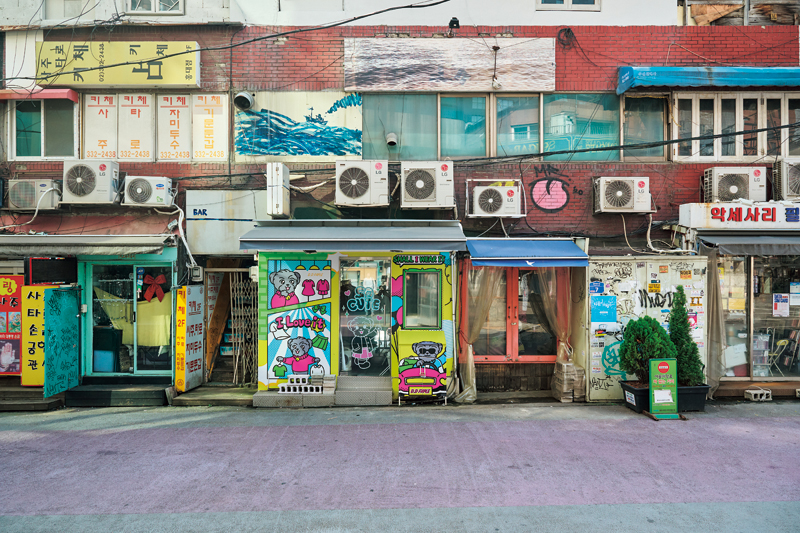
Trains once passed through the area near Hongik University. Few traces of the abandoned railway remain, but a cluster of buildings erected along the tracks have endured. Known collectively as Seogyo 365, the buildings retain their quaint old charm and now house cafés, restaurants, and shops.
Hongdae, a network of streets and alleys near Hongik University in Sangsu-dong, Seoul, is characterized by a youthful vibe and a distinctive culture centered on university students. The bustling neighborhood is known for its diverse artistic offerings from fine arts and music to theater, film, and street performances. Over the years, the growing concentration of creative industries — including design, comics, publishing, advertising, fashion, and digital content — has turned the area into a cultural hub and playground for trendsetters. Roaming its streets today are a mix of free-spirited university students, artists, clubbers, and hipsters as well as cultural producers and entrepreneurs. This dynamic energy is why Hongdae continues to draw large crowds.
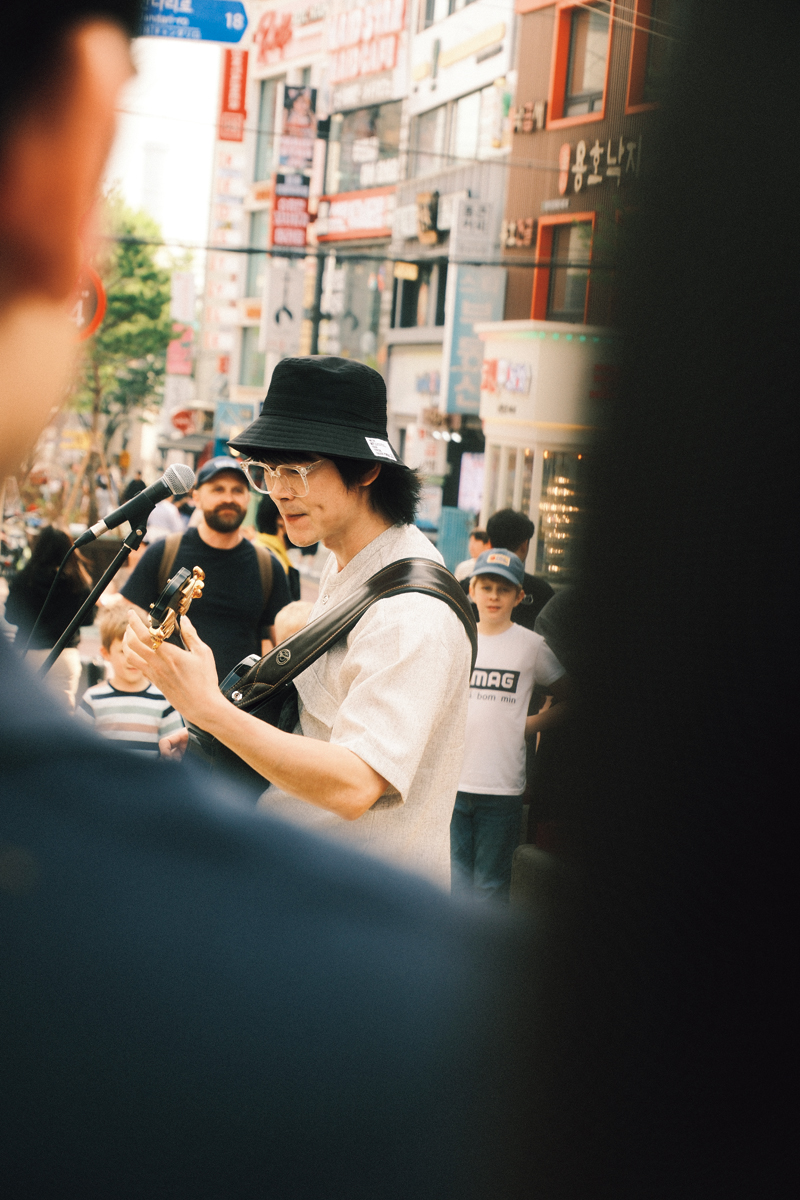
Street musicians are a common sight in Hongdae. Following the neighborhood’s revitalization in the 1990s, it became a popular busking spot, and many aspiring singers who once performed here later went on to become famous artists.
© Choi Tae-won
THE GREATER HONGDAE AREA
Hongdae was initially referred to as “Hongdae-ap” (meaning “in front of Hongik University”), which mirrored the names of other university areas, such as “Yondae-ap” (Yonsei University) or “Edae-ap” (Ewha Womans University). Following the opening of Hongik University Station on Subway Line 2 in 1984, the area was also referred to as “Hongdae-ipgu” (“entrance to Hongik University”).
In the late 1990s, the Seoul Metropolitan Government launched an initiative to create walkable streets across the city. As part of this project, a section in front of Hongik University was converted into a pedestrian-friendly street, giving rise to the name “Hongdae Street.” Through its recent history, the neighborhood has gone by different names and gradually expanded to encompass more areas, so some even refer to it as the “Hongdae District.”
The launch of additional subway lines nearby has further contributed to the expansion of Hongdae’s geographical scope. Since 2000, when Subway Line 6 opened, Hongdae has been developing into Seoul’s largest commercial zone, stretching from Hongik University Station and Hapjeong Station to Sangsu Station. In administrative terms, it covers a broad area, from the initial neighborhoods of Seogyo-dong, Sangsu-dong, and Donggyo-dong to Yeonnam-dong, Yeonhui-dong, Hapjeong-dong, Mangwon-dong, and Seongsan-dong.
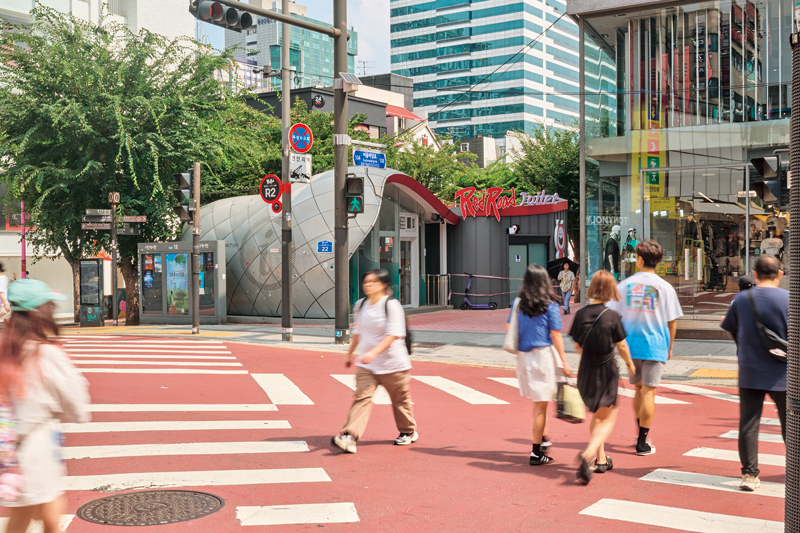
The entrance of Eoulmadang Street, considered the starting point of the Hongdae area. In the vicinity, there is a concentration of large franchise stores and a tourist information center. The main entrance of Hongik University is around 200 meters up the road.
RAILWAY REMNANTS
Located on the banks of the Han River, the Seoul Thermal Power Plant had a great influence on the development of Hongdae. More commonly known as the Danginri Power Plant (named after its location), it was Korea’s first power station. Completed in 1930, it received coal and supplies via the Danginri Line, which had opened a year earlier. Over time, as gas replaced coal, the railway became obsolete, and the line was decommissioned in 1980.
A narrow strip of low-rise buildings, called Seogyo 365, is what remains of the Danginri Line. A road and parking lot were built over the abandoned railway, and in some sections, two- to three-story buildings were erected, just two to five meters wide and standing tightly crowded together. The 200-meter-long strip of buildings derived its name from its former land lot-based address: 365 Seogyo-dong.
The cluster of low-rise buildings here stands in stark contrast to the glossy, modern high-rises nearby. Disputes over their demolition are ongoing, but the shabby structures have so far endured thanks to the efforts of merchants and architects who cherish these vestiges of the past. The eclectic buildings — housing one-of-a-kind restaurants, trendy bars, and artists’ studios — are a big part of what attracts visitors to this area.
The road once crossed by the historic Danginri Line was transformed into a commercial zone after unauthorized structures in the area were torn down and replaced by cafés, bars, and restaurants; before long, it became the heart of the Hongdae area. Last year, the Mapo District Office designated the street, which runs for about two kilometers from Exit 7 of Hongik University Station to Sangsu Station, as a special tourist zone and dubbed it the “Red Road” after painting it that color. It connects popular spots such as the Gyeongui Line Forest Park, Hongdae, and the Danginri Power Plant. The latter is currently being redeveloped by architect Minsuk Cho and his firm Mass Studies to become a multipurpose cultural space with an exhibition hall and performance venue. The renovated landmark is scheduled for completion in 2026.
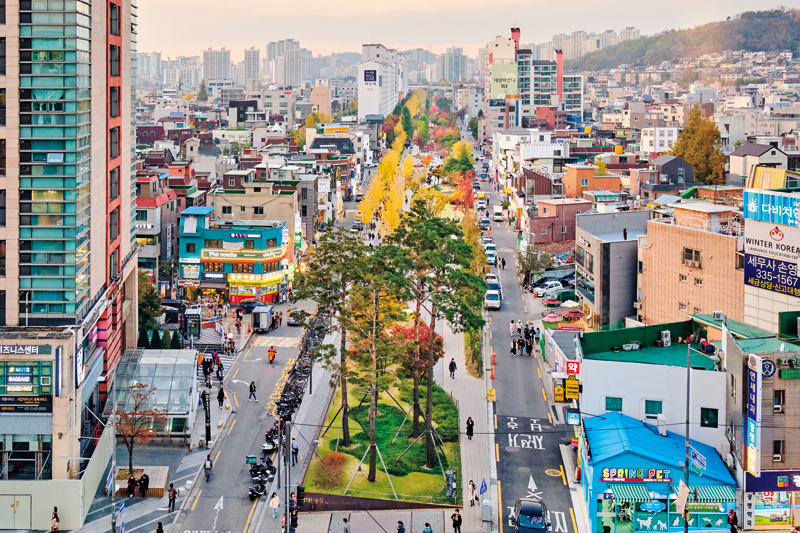
The Gyeongui Line Forest Park is a long strip of urban green space. Created in 2016 along an old railway track, it is a popular spot for relaxation and leisurely walks.
© Mapo District Office
BEGINNINGS OF HONGDAE CULTURE
The beginnings of Hongdae’s distinctive culture, characterized by a mix of indie, alternative, and underground cultures, can be traced back to 1955 when Hongik University was relocated to Sangsu-dong. It was its College of Fine Arts in particular that shaped the identity of the area in the 1970s and 1980s. During this period, many ateliers opened, and art academies, workshops, bookstores, and galleries set up shop here. The initial art academies often began modestly from the ateliers. Then, in 1986, a veritable art academy street began to develop, with private institutions preparing students for their college entrance exams lining both sides of the road stretching from the university to Sanwoollim Theater. They became a defining feature of Hongdae’s cityscape, but since 2013, when the College of Fine Arts abolished practical exams, their number has been dwindling.
The Hongdae area started attracting attention and receiving media coverage with the arrival of quirky cafés in the early 1990s. The cafés and art galleries that began popping up were frequented by artists and gave the neighborhood a free-spirited and trendy atmosphere. Cafés run by artists also grew in number, forming a café alley between the main entrance of Hongik University and the Far East Broadcasting Company and parking lot that became known as Picasso Street.
Along with these developments came a rise in consumer culture, which sparked growing concerns. In response, Hongik University’s art students launched the Street Art Exhibition in 1993 to protect Hongdae’s identity. At the event, held annually at first, students painted murals on the walls of the local streets, giving birth to Hongdae Mural Alley.
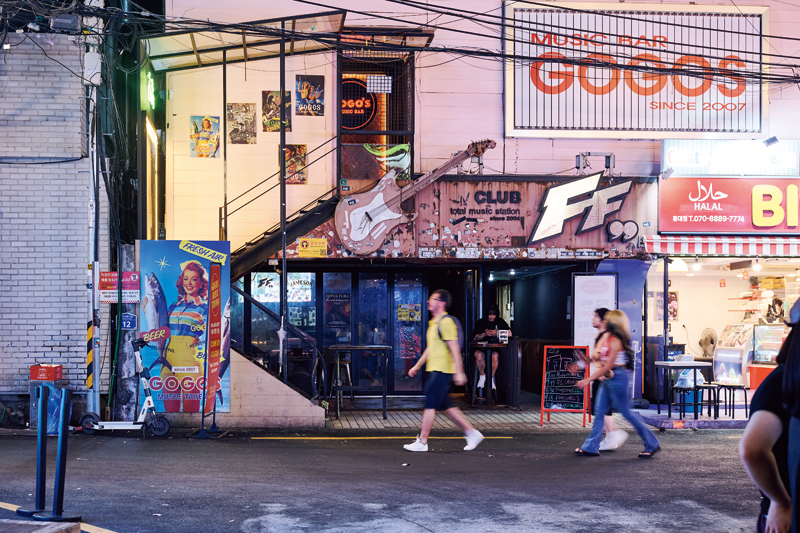
Live music clubs spearheaded the indie music scene that developed in the Hongdae area. Among them was CLUB FF, which celebrates its 20th anniversary this year. It remains the go-to place for rock music, with famous acts such as Crying Nut and the Seoul Electric Band regularly performing here.
RESISTANCE TO CONFORMITY
During the mid- to late-1990s, live music clubs began proliferating in Hongdae, forming another key component of the distinctive local culture. The existing art scene, coupled with the newly emerging consumerism, spawned Hongdae’s club scene. Café Kraftwerk, which opened in 1992, is a notable example. It was a music studio that evolved into a bar, becoming a prototype of the dance clubs that followed. In 1994, live music clubs featuring experimental acts enjoyed a boom, with Drug leading the trend. These clubs were an outlet for those seeking an alternative form of entertainment. From the 2000s, a series of festivals were held at the clubs to help bolster their identity.
The Hongdae area, which developed into a center of art and culture, took on a new identity as a cultural tourism zone with the support of government-funded projects during the Korea-Japan World Cup 2002. This accelerated its transition from a place catering to lovers of underground culture to a mainstream tourist attraction. But this had unforeseen repercussions, namely rent increases that threatened the livelihood of small theaters and performance halls, which then sparked a movement to protect these establishments. Amid such circumstances, a host of new festivals were launched in Hongdae, such as the Seoul Fringe Festival, the Korea Experimental Arts Festival, and the Seoul Wow Book Festival.
Nevertheless, the influx of big capital has led to the closure of many smaller cultural venues. The entities that played a key role in molding Hongdae’s culture and identity are disappearing one by one. Even through this crisis, Hongdae is pushing back, resisting commercialization and conformity, and thanks to its accumulated cultural power, the area continues to evolve with the times. Key figures in the cultural industry are continually reshaping and adding to Hongdae’s ecosystem. Owing to their unwavering determination, the authentic character and vibe of Hongdae will remain strong.